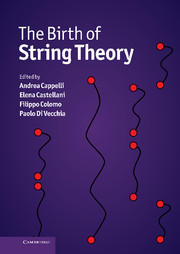Book contents
- Frontmatter
- Contents
- List of contributors
- Photographs of contributors
- Preface
- Abbreviations and acronyms
- Part I Overview
- EARLY STRING THEORY
- Part II The prehistory: the analytic S-matrix
- 5 Introduction to Part II
- 6 Particle theory in the Sixties: from current algebra to the Veneziano amplitude
- 7 The path to the Veneziano model
- 8 Two-component duality and strings
- 9 Note on the prehistory of string theory
- Part III The Dual Resonance Model
- Part IV The string
- TOWARDS MODERN STRING THEORY
- Part V Beyond the bosonic string
- Part VI The superstring
- Part VII Preparing the string renaissance
- Appendix A Theoretical tools of the Sixties
- Appendix B The Veneziano amplitude
- Appendix C From the string action to the Dual Resonance Model
- Appendix D World-sheet and target-space supersymmetry
- Appendix E The field theory limit
- Index
5 - Introduction to Part II
from Part II - The prehistory: the analytic S-matrix
Published online by Cambridge University Press: 05 May 2012
- Frontmatter
- Contents
- List of contributors
- Photographs of contributors
- Preface
- Abbreviations and acronyms
- Part I Overview
- EARLY STRING THEORY
- Part II The prehistory: the analytic S-matrix
- 5 Introduction to Part II
- 6 Particle theory in the Sixties: from current algebra to the Veneziano amplitude
- 7 The path to the Veneziano model
- 8 Two-component duality and strings
- 9 Note on the prehistory of string theory
- Part III The Dual Resonance Model
- Part IV The string
- TOWARDS MODERN STRING THEORY
- Part V Beyond the bosonic string
- Part VI The superstring
- Part VII Preparing the string renaissance
- Appendix A Theoretical tools of the Sixties
- Appendix B The Veneziano amplitude
- Appendix C From the string action to the Dual Resonance Model
- Appendix D World-sheet and target-space supersymmetry
- Appendix E The field theory limit
- Index
Summary
Introduction
Part II deals with theoretical particle physics in the Sixties and the developments that led to the Veneziano formula for the scattering amplitude of four mesons – the very beginning of string theory. In this Introduction, we provide some background for these developments.
We begin by recalling some aspects of quantum field theory, the basic theory for describing elementary particles and fundamental interactions. Quantum field theory was fully developed during the Fifties and successfully applied to the description of the electromagnetic force, leading to quantum electrodynamics (QED), the theory of photons, electrons and positrons. Remarkably, QED predicted new quantum-relativistic effects, such as the anomalous magnetic moment of electrons and the Lamb shift in atomic spectra, which were confirmed experimentally to very high precision.
A crucial aspect of the theory was the presence of a small parameter, the fine-structure coupling constant α ∼ 1/137: all quantities could be expanded in power series of α, the socalled perturbative expansion, and the first few terms were precise enough to be compared with the experimental data. This approximation allowed the complexity of field interactions to be disentangled.
At the beginning of the Sixties, quantum field theory methods were also applied to the weak nuclear force (responsible for radioactive decays) and the strong force (gluing protons and neutrons inside nuclei), the names clearly indicating their strength. Weak interactions could be described within perturbative quantum field theory, although with the limitations due to the incompleteness of the Fermi theory (see Appendix A for more details).
- Type
- Chapter
- Information
- The Birth of String Theory , pp. 83 - 99Publisher: Cambridge University PressPrint publication year: 2012
- 1
- Cited by

